2007 Puzzle Design
Competition
|
|
2007 Puzzle Design
Competition
|
|
| The 2007 IDC Guide (photos, instructions, and relevant notes) is available here. |
The following is a summary and buying guide for the 55 entries in the 2007 competition (click on images for larger photos).
All designs are copyrighted and are the intellectual property of the designer. All rights are reserved.
(Now they know how many holes it takes to fill) The L-Bert Hall Designer: Ronald Kint-Bruynseels Materials: Wood: cocobolo, jacarunda pardo and birch. Purchase: Check availability and price at: www.cubicdissection.com. About 30 copies will be available after IPP27. Price: $60 to $70. |
 |
|
Designer: Robert Reid Materials: ABS plastic Notes: This puzzle is actually a demonstration of a space filling object. Each object is made up of four pyramids which have transverse sections of regular pentagons. The way that 12 fit together at an apex is that of the regular dodecahedron, not that of the rhombic dodecahedron. Purchase: For sale at www.puzzlepalace.com. |
 |
|
Designer: Edi Nagata Materials: MDF board Purchase: Overseas order form at the designer's web site, or contact via Email (edi001@witful.net). |
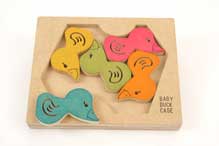 |
|
Designer: Katsuhiko Okamoto Materials: ABS resin Notes: There are three geometric elements of a cube: the face, the vertex, and the edge. When the faces turn it's a Rubik's Cube; when the vertices turn it's a Skewb; and when the edges turn it's the Bevel cube! Rotations besides 180 degrees are possible, allowing very unexpected movement and shapes. |
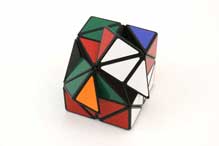 |
|
Designer: Vladimir Krasnoukhov and James Dalgety Materials: Wood (wenge, bubinga, and beech) Purchase: Reproduction available from Bits and Pieces. |
 |
|
Designer: George Miller and Vesa Timonen Materials: ABS and Acrylic Purchase: For sale at www.puzzlepalace.com for $370. |
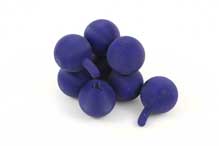 |
|
Designer: Erik Johansson Materials: Mahogany Purchase: Please visit www.tankenotter.se for info. |
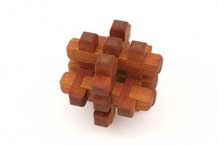 |
|
Materials: Zinc alloy Purchase: Available from most Hanayama retailers. |
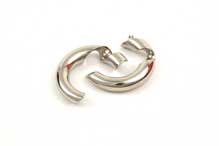 |
|
Designer: Vladimir Krasnoukhov Materials: Wood (oak and bubinga) |
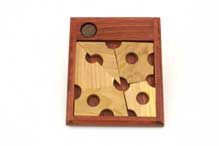 |
|
Designer: Erik Johansson Materials: Birch wood and polyester rope Purchase: Please visit www.tankenotter.se for info. |
 |
|
Designer: Bob van Etten Materials: Plastic pieces and case. Purchase: Puzzle can be purchase from Here to There puzzles. Price will be $35.00 plus shipping. |
 |
|
Designer: Robert Yarger Materials: Bloodwood, beli, puprleheart, magnets Purchase: Currenlty 6 out of 30 puzzles are left and can be purchased for $555 at www.cubicdissection.com or by contacting Robert Yarger at stickmanbox@aol.com. |
 |
|
Designer: Kirill Grebnev Materials: Plexiglas Purchase: Please visit my web site: puzzle.palyn.ru/, or write me: postmaster@palyn.ru. |
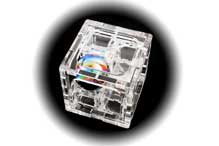 |
|
Designer: Sam Cornwell Materials: Mahogany |
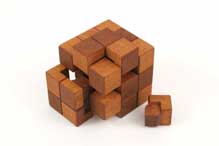 |
|
Designer: Albert Gübeli Materials: ABS, 3d Printer Purchase: Web site: www.albinegri.ch. Three puzzles produced; price $300. |
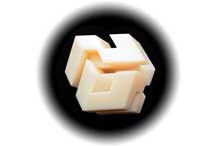 |
|
Designer: Kate Jones Materials: Laser-cut acrylic tiles in a red acrylic tray, with wavy hexagon inset, 23 tiles with total area of 57 diamonds, hand-inlaid with white, black and gray diamonds in star-like patterns. Notes: The periodic pattern of two-color stars embedded in hexagons of a third color was originally conceived as the basis for a game board. Purchase: Contact Kadon at www.gamepuzzles.com. Price: $75. Not a limited edition; we'll make as many as we can sell, in batches of 10 at a time. |
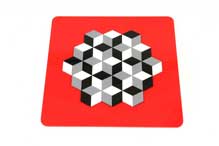 |
|
Designer: Hans van Klaveren Materials: Plastic dices and (minor) flexible colorful string Purchase: Limited stock. Price 35,00 € each. Variations are possible: all nrs. on same side - centre dice integrated. Contact manufacturer: klaveren@chello.nl. |
 |
|
Designer: Eric Harshbarger Materials: Pieces: machined aluminum; box: pine or poplar Purchase: Currently I only have about a dozen sets left at $200 each. More information about larger, future production runs and manufacture will be available at my website: www.ericharshbarger.org. |
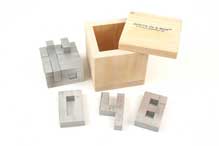 |
|
Designer: Hirokazu Iwasawa Materials: Wire and chain. |
 |
|
Designer: Koshi Arai Materials: Natural Wood coated MDF Purchase: Contact the designer via email: karai@earth.email.ne.jp. |
 |
|
Designer: Vaclav Obsivac Materials: Plum Purchase: Contact via e-mail: vinco@centum.cz. Price is 20 €. |
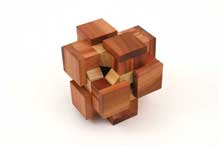 |
|
Designer: Tom Tolman Materials: Maple with acrylic Purchase: Licensing information available from tolman@gmail.com |
 |
|
Designer: Stephen Chin Materials: Australian woods, pins magnets Purchase: Contact the designer: chins@ihug.com.au. |
 |
|
Materials: Natural wood and synthetic string Purchase: Please visit my web site: puzzle.palyn.ru/, or write me: postmaster@palyn.ru. |
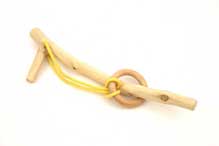 |
|
Designer: Stewart Coffin Materials: wood |
 |
|
Designer: Simon Bexfield Materials: Ebony, satinwood, and magnets Purchase: Contact designer via email (puzzles@bexfield.com). The puzzle will be made in a limited numbered edition of up to 100 in a variety of woods. |
 |
|
Designer: Dale Walton and Dick Hess Materials: Wood Notes: This is the minimum number of pieces known which allows three shapes at different scales to be built. Purchase: Contact the designer at rihess@cox.net. Less than 30 available at $20 each. |
 |
|
Designer: Lozac'h René Materials: Wood, paper and glass Purchase: Contact the designer via email; rlozach@free.fr. |
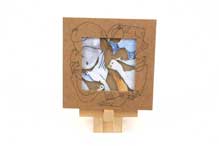 |
|
Designer: Hans van Klaveren Materials: Plastic dices and cylindrical magnets Purchase: Limited stock. Price 49,50 € each. Variation possible: numbers in random order on each side of the super dice.Contact manufacturer: klaveren@chello.nl |
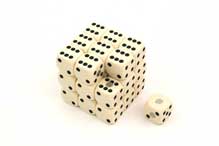 |
|
Designer: Tom Tolman Materials: Maple with polyurethane, screws and screw caps. |
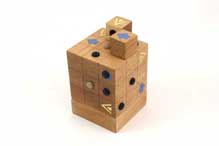 |
|
Designer: Hiroshi Mori Materials: Wood (hemlock and poplar, oil coated) |
 |
|
Designer: Lozac'h René Materials: Wood (beech or ash), PCV and brass Purchase: Contact the designer via email; rlozach@free.fr. |
 |
|
Designer: Ichiro Kohno Materials: solid wood, poplar Purchase: ¥1,500yen apiece; 5 available one month after IPP. |
 |
|
Designer: Mineyuki Uyematsu Materials: Wood (keyaki jindai, mobingi, pao rosa) |
 |
|
Designer: Albert Gübeli Materials: Plywood Purchase: www.albinegri.ch craft made, 5 puzzles are avaible, price $60. |
 |
|
Designer: Derek Bosch Materials: Kingwood, holly, East Indian rosewood, tulipwood splines, poplar dowels Purchase: Two puzzles are available for sale at $150 from Tom Lensch. More can be made based on demand. |
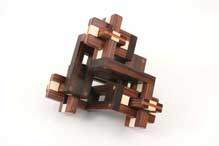 |
|
Designer: Erik Johansson Materials: Birch wood and polyester rope Purchase: Please visit www.tankenotter.se for info. |
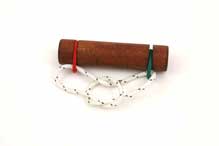 |
|
Designer: Ichiro Kohno Materials: spring, yew, teak, poplar Purchase: ¥2,500yen apiece; 5 available one month after IPP. |
 |
|
Designer: Ichiro Kohno Materials: Bottle, yew and teak Purchase: ¥1,500yen apiece; 5 available one month after IPP. |
 |
|
Designer: Pantazis Houlis Materials: Transparent square plastic tiles with diagonal grooves, connecting strings, and paper tiles inserted between the plastic tiles. Notes: The puzzle is based on the mechanism with square tiles and strings that is used on the Rubik's Magic. A critical difference is that this puzzle uses an odd number of tiles. It is because of the odd number of tiles that this puzzle can never become flat. And it is the same reason that there is no shape-parity, giving the puzzle approximately double the combinations of other even numbered-tile puzzles. Purchase: Contact the designer. Price is US $75 (not including postage). |
 |
|
Designer: Shiro Tajima Materials: Kenponashi |
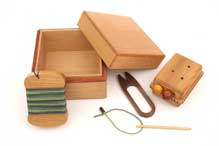 |
|
Designer: Hiroshi Mori Materials: Wood (hemlock) |
 |
|
Designer: Tsugumitsu Noji Materials: Maple, white ash, bubinga |
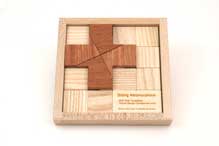 |
|
Designer: Kagen Schaefer Materials: Snakewood, prehistoric kauri wood, ebony, maple Notes: Snakewood is one of the hardest woods in the world. It has a very unique quality of showing a spotted snakeskin figure radiating in all directions. The prehistoric kauri wood is carbon dated somewhere between 30,000 and 50,000 years old. The ancient trees fell long ago and stayed preserved in bogs. Ancient kauri wood is excavated out of the ground in New Zealand. Purchase: Limited edition of 10 from these materials. Price: $650. Contact designer at www.kagenschaefer.com/. |
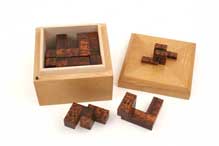 |
|
Materials: Plexiglas Purchase: Please visit my web site: puzzle.palyn.ru/, or write me: postmaster@palyn.ru. |
 |
|
Designer: Ludovic Robillard Materials: Hardened steel, PVC, ferrite Purchase: Tamashido is availlable for 32 € + shipping charges at www.gataris.com or though e-mail: ludovic@gataris.com. |
 |
|
Designer: Brian Young Materials: The telephone box is made from satin sycamore timber and finished with brass hardware. The letters of the telephone box are made from other exotic Australian timbers: T-blush alder, E-grey gum, L-Queensland blackbean, E-grey gum, P-red oak, H-brown
quondong, O-saffron heart, N-flooded gum, E-grey gum, b-red oak, o-black wattle,
x-blackbutt. Notes: The box is a replica of a full size 1940’s Queensland PMG telephone box. Purchase: The puzzle may also be purchased from Mr Puzzle Australia’s website and shipped worldwide. |
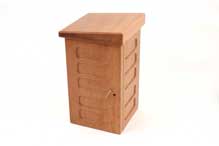 |
|
Designer: Joe Becker Materials: ping-pong balls |
 |
|
Designer: Ray Fischer Materials: Various laminates, rosewood Purchase: See webpage www.torbuspuzzles.com. Price ranges from $100 to $300 depending on type of material and percision of cut. Several dozen on hand. There are no other similar puzzles and these are patented. |
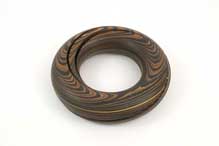 |
|
Designer: Ray Fischer Materials: Oak, steel Purchase: See webpage www.torbuspuzzles.com. Price ranges from $100 to $300 depending on type of material and percision of cut. Several dozen on hand. There are no other similar puzzles and these are patented. |
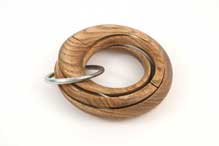 |
|
Materials: Magnolia kobus Notes: To assemble or disassemble the Tornado Burr, you must twist the group of 4 pieces simultaneously. Also, such a movement should be done for the other group of 4 pieces one more time.; The most important key of the Tornado Burr is the slanted notches. The slanted notches demand that each piece is assembled and disassembled in the proper order. As you can see, the Tornado Burr has very eccentric movements. Try your luck, and stop this fierce tornado. |
 |
|
Designer: Nikolay Stanev Materials: Brass |
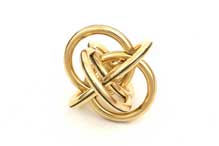 |
|
Designer: William Waite Materials: black walnut and red alder wood Notes: Not all solutions have the same type of symmetry. Purchase: available at www.puzzlemist.com. Price: $20 each. |
 |
|
Materials: ABS resin Notes: There are no center cubes! |
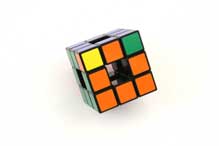 |
|
Designer: Louis Toorenburg Materials: Wood, cardboard Purchase: Contact via Labyrinth Woodworks web site. |
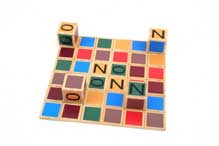 |
| © 2001-2007 by Puzzle Design Competition Committee |